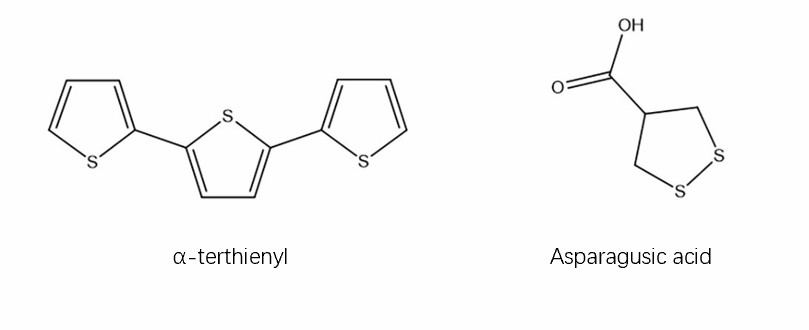Control of Plant Nematodes by Organosulfur Compounds
Organosulfur compounds are a subclass of organic substances that contain sulfur and are known for their varied occurrence and unusual properties. They occur in the bodies of all living creatures in the form of certain essential amino acids (such as cysteine, cystine, and methionine, which are components of proteins) of the tripeptide glutathione, and of enzymes, coenzymes, vitamins, and hormones. It is reported that some organosulfur compounds have sound nematocidal effects.
Lifeasible possesses enriched experience in plant science, performing various strategies to help our clients analyze the role of organosulfur compounds in the biological control of plant nematodes. Our scientists and expert technicians have been dedicated to customizing your program to meet your requirements.
Analysis of the α-Terthienyl
- α-terthienyl is recognized for its nematocidal, insecticidal, fungicidal, antiviral, and cytotoxic activities and is now believed to be the main compound responsible for the nematocidal activity of marigolds. It is believed to be a potential candidate for non-residual and environmentally friendly pesticides.
 Fig.1 Structure of two nematocidal organosulfur compounds.
Fig.1 Structure of two nematocidal organosulfur compounds.
- Lifeasible provides analysis services of the α-terthienyl against plant nematodes, including analyzing the correlation between the concentration of α-terthienyl and nematode population suppression, examining the nematocidal activity of α-terthienyl against young adults, dauer larvae, and second juvenile stage of plant nematodes and so on.
- In addition, we help customers to analyze nematocidal mechanisms of α-terthienyl, such as physical penetration of nematode subcutaneous tissues, induction of oxidative stress within nematodes, etc.
Analysis of Asparagusic Acid
- Several species of the genus Asparagus have been demonstrated to have chemicals in their roots that are antagonistic to plant parasitic nematodes, which have been identified as the organosulfur compound asparagusic acid.
- While asparagusic acid biosynthesis is believed to be unique to asparagus and is poorly understood, it likely involves isobutyric acid and methacrylic acid as precursors and the amino acid cysteine as the donor of at least one of the sulfur atoms
- We provide analysis services of the derivatives of fatty acids against plant nematodes, such as the study of the inhibitory effect of different asparagine acid concentrations on nematodes. Furthermore, we are pleased to help our customers do some mechanistic research to uncover the truth about the nematicide of asparagusic acid.
Lifeasible is pleased to share our cutting-edge technology and extensive expertise in plant science to facilitate our clients' research and project development. We can offer high-quality customized services by adjusting protocols to meet specific requirements. If you are interested in our services or have any questions, please feel free to contact us or make an online inquiry.
For research or industrial raw materials, not for personal medical use!
 Fig.1 Structure of two nematocidal organosulfur compounds.
Fig.1 Structure of two nematocidal organosulfur compounds.